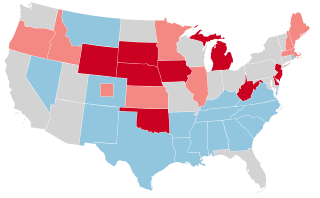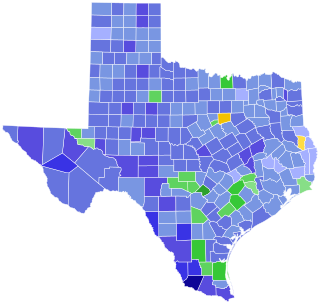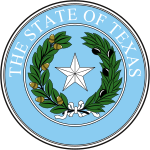
The 1948 United States Senate elections were elections which coincided with the election of Democratic President Harry S. Truman for a full term. The 32 seats of Class 2 were contested in regular elections, and one special election was held to fill a vacancy. Truman had campaigned against an "obstructionist" Congress that had blocked many of his initiatives, and in addition the U.S. economy recovered from the postwar recession of 1946–1947 by election day. Thus Truman was rewarded with a Democratic gain of nine seats in the Senate, enough to give them control of the chamber. This was the last time until 2020 that Democrats flipped a chamber of Congress in a presidential election cycle.

The 1942 United States Senate elections were held November 3, 1942, midway through Franklin D. Roosevelt's third term as president. The 32 seats of Class 2 were contested in regular elections, and two special elections were held to fill vacancies.

The 1936 United States Senate elections coincided with the reelection of President Franklin D. Roosevelt. The 32 seats of Class 2 were contested in regular elections, and special elections were held to fill vacancies. The Great Depression continued and voters backed progressive candidates favoring Roosevelt's New Deal in races across the country. The Democrats gained 5 net seats during the election, and in combination with Democratic and Farmer–Labor interim appointments and the defection of George W. Norris from the Republican Party to become independent, the Republicans were reduced to 16 seats. The Democrats' 75 seats and their 59-seat majority remain their largest in history.

The 1930 United States Senate elections occurred in the middle of Republican President Herbert Hoover's term. The 32 seats of Class 2 were contested in regular elections, and special elections were held to fill vacancies. With the Great Depression beginning to take hold, Republican incumbents became unpopular, and Democrats picked up a net of eight seats, erasing the Republican gains from the previous election cycle. Republicans retained control of the U.S. Senate since Vice President Charles Curtis cast the tie-breaking vote. This was the first of four consecutive Senate elections during the Depression in which Democrats made enormous gains, achieving a cumulative pick-up of 34 seats.

The 1924 United States Senate elections were elections for the United States Senate which coincided with the election of Republican President Calvin Coolidge to a full term. The 32 seats of Class 2 were contested in regular elections, and special elections were held to fill vacancies. The strong economy and Coolidge's popularity helped Republican candidates increase their majority by 3.

The 1922 United States Senate elections were elections that occurred in the middle of Republican President Warren G. Harding's term. The 32 seats of Class 1 were contested in regular elections, and special elections were held to fill vacancies. With the Republicans divided between conservative and progressive factions, the Democrats gained six net seats from the Republicans while the Farmer–Labor party gained one. The Republicans retained their Senate majority.

The 1934 United States Senate election in Texas was held on November 4, 1934. Incumbent Democratic U.S. Senator Tom Connally was re-elected to a second term. Connally fended off a competitive primary challenge from U.S. Representative Joseph Weldon Bailey Jr. on July 28 before facing only nominal opposition in the general election.

The 1964 United States Senate election in Texas was held on November 3, 1964. Incumbent Democratic US Senator Ralph Yarborough defeated future US President George H. W. Bush handily. This would prove to be Yarborough's final term as a senator. Bush later went on to win an election for the US House of Representatives in 1966 and was subsequently elected US Vice President in 1980, re-elected in 1984, and was elected president in 1988.

The 1942 United States Senate election in Texas was held on November 3, 1942. Incumbent Democratic U.S. Senator W. Lee "Pappy" O'Daniel was re-elected to a second term.

The 1916 United States Senate election in Texas was held on November 7, 1916. Incumbent Democratic U.S. Senator Charles Culberson was re-elected to a fourth term in office. Culberson survived a challenge from former Governor Oscar Colquitt in the Democratic primary, then easily won the general election.

The 1918 United States Senate election in Texas was held on November 5, 1918. Incumbent Democratic U.S. Senator Morris Sheppard was re-elected to a second term in office easily.

The 1922 United States Senate election in Texas was held on November 7, 1922. Incumbent Democratic U.S. Senator Charles Culberson ran for re-election to a fifth term, but lost the Democratic primary. A runoff was held between former Governor Pa Ferguson and Railroads Commissioner Earle Bradford Mayfield.

The 1924 United States Senate election in Texas was held on November 4, 1924. Incumbent Democratic U.S. Senator Morris Sheppard was re-elected to a third term in office, easily dispatching his challengers.

The 1928 United States Senate election in Texas was held on November 6, 1928. Incumbent Democratic U.S. Senator Earle Mayfield ran for re-election to a second term.

The 1936 United States Senate election in Texas was held on November 3, 1936. Incumbent Democratic U.S. Senator Morris Sheppard was re-elected to a fifth term in office, easily dispatching his challengers.

The 1940 United States Senate election in Texas was held on November 5, 1940. Incumbent Democratic U.S. Senator Tom Connally was re-elected to his third term in office, with only minor opposition in the Democratic primary and general elections.

The 1946 United States Senate election in Texas was held on November 5, 1946. Incumbent Democratic U.S. Senator Tom Connally was re-elected to his fourth term in office, with only minor opposition in the Democratic primary and general elections.

The 1954 United States Senate election in Texas was held on November 2, 1954. Incumbent Democratic U.S. Senator Lyndon Baines Johnson was re-elected to a second term in office, easily dispatching his challengers.

The 1930 Arkansas gubernatorial election was held on November 4, 1930, to elect the Governor of Arkansas, concurrently with the election to Arkansas's Class II U.S. Senate seat, as well as other elections to the United States Senate in other states and elections to the United States House of Representatives and various state and local elections.
There were three special elections to the United States Senate in 1941 during the 77th United States Congress.






















